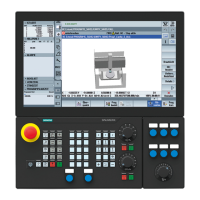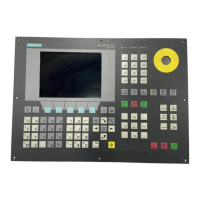Detailed Description
2.11 EMERGENCY STOP (N2)
NC/PLC Interface Signals (Z1)
Function Manual, 08/2005 Edition, 6FC5397-0BP10-0BA0
2-113
2.11 2.11 EMERGENCY STOP (N2)
2.11.1 Signals to NC (DB10)
DB10
DBX56.1
EMERGENCY STOP
Edge evaluation: no Signal(s) updated: cyclic
Signal state 1 or
edge change
0 → 1
The NC is switched to the EMERGENCY STOP state and the EMERGENCY STOP procedure is
started on the NC.
Signal state 0 or
edge change
1 → 0
The NC is not in the EMERGENCY STOP state.
The EMERGENCY STOP status is (still) active but can be reset using the interface signals:
DB10 DBX56.2 (acknowledge EMERGENCY STOP)
and
DB11 DBX0.7 (mode group reset)
Corresponding to .... DB10 DBX56.2 (acknowledge EMERGENCY STOP)
DB10 DBX106.1 (acknowledge EMERGENCY STOP)
DB10
DBX56.2
Acknowledge EMERGENCY STOP
Edge evaluation: no Signal(s) updated: cyclic
Signal state 1 or
edge change
0 → 1
The EMERGENCY STOP state is only reset if the interface signal:
DB10 DBX56.2 (acknowledge EMERGENCY STOP)
is set followed by the interface signal:
DB11, ... DBX0.7 (mode group reset).
It must be noted that IS "Acknowledge EMERGENCY STOP" and IS "Reset" must be set (together)
for a long enough period so that the interface signal:
DB10 DBX106.1 (EMERGENCY STOP active)
was reset.
Resetting the EMERGENCY STOP state has the following effects:
• The controller enable is switched in
• Follow-up mode is canceled for all axes and position control mode resumed
• DB31, ... DBX61.5 set (position controller active)
• DB11, ... DBX6.3 set (mode group ready)
• DB10 DBX106.1 reset (EMERGENCY STOP active)
• Alarm 3000 is canceled
• Part program processing is interrupted for all channels

